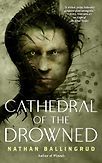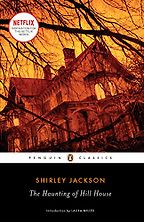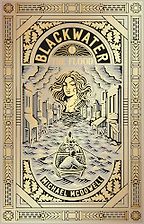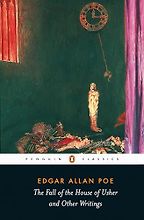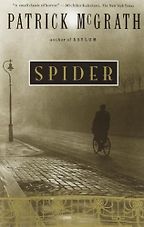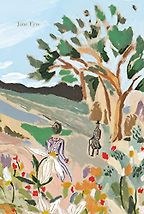What are the defining features of Gothic horror for you?
That’s something I thought about a lot before starting The Lunar Gothic Trilogy. I was concerned that I’d be committing myself to a set of rules I didn’t know. But it seems to me that the boundaries defining the Gothic can be permeable, so I took that as a license to just go with it and have fun.
I think of a particular Freudian phrase, which has been applied to the Gothic usefully: ‘the return of the repressed.’ I think that’s a fundamental ingredient of Gothic literature. Another ingredient that appears often in the Gothic is the punishment of hubris. I think of it as primarily a dark psychological fiction, in which the psychology is manifested physically in the world the character is living in.
Of course, there are also the tradition trappings: the old houses, the cobwebs, the old churches or abbeys. I am completely in love with the cover art of mid-20th century Gothic romance novels, where a woman flees from some dark edifice in the background, with maybe one lighted window near the top. I find those to be so evocative. They just stir the imagination.
Let’s begin with an old house, then. Could you tell us about Shirley Jackson’s The Haunting of Hill House?
Shirley Jackson’s The Haunting of Hill House is, to me, the perfect horror novel. It’s one of the magnificent achievements of literature in the 20th century.
In very broad strokes, it’s about a woman who goes into an old house with some other people and… oh boy, how do I even make an elevator pitch for it? The house manifests – or is a manifestation of, arguably – her mental illness. It takes the form of hauntings, which seem to be real enough to her and to the other people in there. The narrator reckons with the notion that this house itself may be an entity: a living, breathing, malevolent consciousness.
The story is a beautifully written, beautifully explicated, and beautifully felt exploration of psychosis, of past trauma bleeding out around the edges of the door that you’ve shut against it – a trauma that will not be contained. That’s a lesson of Gothic fiction over and over again: you can’t keep these things buried. They will come back in awful grandeur.
So in a nutshell, that’s what the novel is – without giving away any of its treats for first-time readers.
Is this a book where we’re genuinely unsure, as a reader, what’s psychosis and what’s reality? Or is it real on the book’s terms?
I think it’s the former. It’s a story that really walks that tight rope when it comes to revealing what is real – is this an actual haunting that she’s experiencing, or is this a psychological experience that she’s having? Shirley Jackson expertly navigates that narrow tunnel between both possibilities. You’re left with questions, a state in which I think Gothic fiction in particular benefits from – horror fiction too, but especially Gothic horror. You’re left uncertain, spiritually troubled.
If Jackson had given us a definitive answer one way or another, it would have been unsatisfying. It would have undermined the entire experience that we’ve had with this protagonist throughout the novel. What she’s experiencing is an emotional, intellectual, spiritual turbulence that is profoundly disorienting, and it is disorienting for the reader too. It leaves us in that state, and that’s one of my favourite qualities about it.
Your second choice is Michael McDowell’s Blackwater. What’s it about?
Blackwater is one of my favourite modern iterations of Southern Gothic fiction. When we were talking about doing this, I knew I had to include a Southern Gothic. The obvious go-tos are Faulkner and Flannery O’Connor, but I wanted to include something a little less well-known.
Blackwater is currently published as one big novel, but really it’s a series of six novellas which tell the story of a family in Perdido, Alabama, situated against the Blackwater River. It’s a generational story; we see this family evolve over decades. The conceit is that in the early part of the 20th century, during a time when the river floods its banks and Perdido is partially submerged, two people rescue someone that they think is a woman trapped on the top floor of a building. In reality, she is a river monster – she can assume human form, but she’s a carnivorous, aquatic predator. They take her back to safety. Eventually, she marries into the family, and they have children. Those children have children, and in time, she becomes a kind of matriarch of this family.
This wide-ranging story is about many things. It’s about Southern life. It’s about the role of women in Southern society. It’s about power dynamics in a family. In a subdued way, it’s about the way queer characters live in this society, and the balance of acceptance and stealth existing between themselves and the people of Perdido. Michael McDowell himself was a gay writer, so he handles this element with delicacy and nuance. The one area I think the novel fails is on the question of race; it’s simply not seriously addressed, though there are certainly Black characters in the story. He missed a trick here because the novel is set during a time when it would have provided a potent subject.
Finally, it’s about a monster in the family who is masquerading as a human, and how sometimes she just has to change back into being a river monster and eat some people. It’s such a beautiful story. I think it was John Langan who described it as Eudora Welty crossed with H.P. Lovecraft, and I can’t think of a better description. I love the story so much I wrote an introduction to the edition published by Valancourt Books. I recommend it to anyone with an interest in the Gothic.
Other than being set in the South, is there anything that makes Southern Gothic its own beast?
One thing that makes it distinct is, of course, the set of physical trappings. Instead of old monasteries or churches – the traditional European set dress of Gothic fiction – you have great old oak trees covered in Spanish moss and the weird liminal zones of swamps; you still have abandoned buildings, but they tend to be old plantation houses or empty farmhouses or simply old, weathered shacks; and you have the great sin, which is slavery. That’s the ultimate repression, both in the actual, physical sense, and later in the way the memory is denied or diminished. The lingering wounds of the Civil War play a role; the Confederate South fought to its own eventual destruction. And then, of course, there’s Jesus. Flannery O’Connor called it “the Christ-haunted South,” and the struggle of fundamentalist Christian belief against a generally secular, progressive society is a huge breeding ground for Gothic expression.
I associate Gothic horror with a very claustrophobic and immediate tension. I’m curious about how McDowell spins that out over six related stories…
Each novella is a jump in time, and it’s by this method that he’s able to take us through the generations. Each also contains its own story, its own microcosm of the larger story. In the first installment, called The Flood, Eleanor – the river monster – is rescued while in her human guise, and she is cared for and eventually married into the Caskey family. The next installment tells another discrete tale in the longer arc of the family’s story.
Take The House, the third novella in the series. In this one, as you might guess, they’re building a house. By this time in the narrative, Eleanor has become the matriarchal figure, and her son has married another woman. Eleanor and her husband have grown rich through the timber business, so they’re somewhat well-to-do, and the house is for their son and his new wife. But it becomes the locus of a power play between Eleanor and the young wife-to-be; she builds them this house, but doesn’t let them move into it. Complicating the struggle is the discovery that the house – a brand new house, mind you – is haunted. (Interestingly, the ghost doesn’t play much of a role later on in the story, and some people think of that as a fault, but I think that’s misunderstanding it. When you live in a setting that is full of river monsters and all the trappings of the Southern Gothic, then you have to accept that ghosts are a natural part of that ecosystem. They require no more explanation than an alligator does.) This drama is concluded by the end of the novella, and we move on to something else in the following one. In this way, I think, McDowell is able to keep the narrative focus tight and claustrophobic, while moving the story along a span of many years.
Your own Gothic horror work is also a series of novellas, and the second is coming out soon: Cathedral of the Drowned, which follows on from Crypt of the Moon Spider. Did you plan the whole series out from the beginning?
I did not have a plan at the beginning. The first novella was just going to be its own thing. But about halfway through it, we jump into the head of another character for a chapter – we leave Veronica, the protagonist, and assume the perspective of a character called Charlie Duchamp for a while. And I had such a good time writing Charlie. I wanted more of him.
Crypt of the Moon Spider takes place on the moon in the 1920s. A man named Dr. Cull runs an asylum there, and Veronica Brink, the protagonist, is committed there by her husband. In writing her perspective, that was the totality of the world I was dealing with. By jumping into Charlie’s head, I suddenly had to illuminate other parts of the setting. Once I did that, it was like opening the windows of a house and discovering that the peculiarities of this setting implied a hell of a lot about the greater world around it. That’s what really broke it open for me. I knew that I wanted to explore each of the three principal characters in their own semi-contained narrative (you can see the influence of Blackwater here). From that, the deeper themes began to reveal themselves: perspective, self-perception, memory.
As for planning it out beyond that, to any granular level – not at all. I’m very much a find-my-way-as-I-go sort of writer. I imagine myself as the guy with a candlestick in a dark place, feeling my way along. By the time I get to the other side, I have an idea of the shape of the room, but before then, I don’t know.
In a way, I’m not surprised to hear about your process, because I found it striking how traditionally separate ideas seem to work together in an impressively organic way. It should feel like a sci-fi-horror mash-up, with the lunar setting, but instead it all feels very unified. Where did the idea for the moon as a setting come from?
I think the phrase ‘lunar gothic’ was the spark. I don’t remember how it came about, but I was immediately in love with the pairing of those two words. I had just finished writing a novel that takes place on Mars called The Strange, and although it’s not a Gothic novel, nor is it really a horror novel, it stemmed from the romantic feeling I felt as a kid whenever I stared up at the moon. Especially in the early twilight, when it’s a chalky little smudge at first, and then when the light goes down, it becomes incandescent. It still feels so potent and magical to me to look at it. And the same thing was true for Mars: I remember my dad pointing out this little pink star and telling me what it was, and it seemed impossible that I was looking at Mars. Mars was a land of adventure, a land of dreams, like Narnia or Oz. It wasn’t a place of science, it was a place of imagination; both of those bodies have always been that for me.
Setting a mad house on the moon might seem a little bit on the nose – obviously, the moon is tied with madness in fiction, and Gothic fiction especially – but Gothic fiction is often not particularly subtle, especially in its earliest expressions, so I was happy to go ahead and be over the top. When I write these kinds of stories, I don’t worry about how absurd they are on their face. I don’t worry about the fact that there are trees on the moon, or that there’s oxygen to breathe, or that for some reason this one guy is able to set up an asylum there when there’s no way that could ever be remotely logistically plausible. Who cares about any of that? It’s the primacy of the idea that matters. I ignore real-world logic altogether, and once I shut that door, I can let the dream logic work itself out. The idea was like something growing, like a fruiting tree. Once you decide to give imagination full rein and not worry about explanation, you’ve unchained something, and it’s enormously exciting how the subconscious rewards you for that. My instinct is to trust my subconscious utterly. I’ve never regretted it.
I know the next book starts on Earth. Do we get back to the moon again?
So, Cathedral of the Drowned is a bigger book than Crypt of the Moon Spider. Crypt was a little over 20,000 words, and Cathedral is 30,000, so it’s half as big again. We do go back to the moon; we spend some time at the Barrowfield Home, the lunar asylum, and we see what’s become of it. But we spend a lot more time on Io, one of Jupiter’s moons, which in this universe is a jungle moon full of screeching saurian creatures and bubbling volcanoes and a cathedral spaceship that has crashed on a beach. We follow two narratives: Charlie Duchamp, who is a side character in Crypt, and Goodnight Maggie, who is a small-time crime boss in Brooklyn, New York, in the 1920s. It gets kind of weird from there; it’s hard to describe without getting into spoilers. We deal with their strange relationship, partly employee-employer, partly mother-son, partly romantic. They’re a very confused couple.
With your next choice, we go beyond even novellas to the pioneer of the Gothic short story. It’s Edgar Allan Poe, and you’ve chosen The Fall of the House of Usher.
Poe is so central to my idea of the Gothic. Especially The Fall of the House of Usher is such a huge inspiration for this particular group of books that I’ve been writing. It’s about an unnamed narrator who is visiting a friend, Roderick Usher, and Roderick is in a bit of a pickle. He has a sister who is very ill, and he’s stuck in this forlorn house out in the English countryside, and it’s literally falling apart around him. This is very much a story in which the psychology of the character is manifested in the house itself. In fact, when the narrator first arrives at the doorstep, he makes a remark that there is a fine fissure starting at the base of the house, running up the side of it – which tells you where this is going to go right away.
Usher is full of the beautiful, baroque language I associate with the Gothic. As with Gothic architecture, the beauty of its expression is part of the point. It’s full of strangeness and weird poetry. It features Edgar Allen Poe’s notorious fascination with the eroticism of death, something I’ve never seen any other writer treat with the same feverish intensity, the same potency as Poe does. In a call-back – or call-forward – to Shirley Jackson’s The Haunting of Hill House, the narrative posits that the house itself may be alive, a malignant thing that wills Roderick Usher’s doom.
It all leads to this hideous revelation – hideous and beautiful and shocking, even to this day. I love it so much.
You’ll often find this story in ‘collected works’ volumes… What else do you recommend from Poe?
His short stories are fantastic. He wrote a vast amount of material that isn’t Gothic horror, but it’s mostly the Gothic horror that lives on to this day. “Ligeia” is a great one. This is about a man who is in love with the titular character. She’s into spooky, forbidden stuff; she talks to him about weird texts and the forbidden knowledge that obsess her. He’s utterly smitten. Then she falls ill, as so many women do in Poe’s stories do, and passes away.
[Spoiler alert]
Later, this narrator marries another woman. He doesn’t love her like he loved Ligeia, but nevertheless they are married. And then she too becomes ill – these are spoilers, but the plot’s conclusion is not what the story is about, the story is about the experience – and as she is dying, she fades, she starts to come back a little bit, and then she fades further, and each time she fades her brief revival is more powerful, more stark. And she’s starting to look more like Ligeia. At the end of the story, she dies — but then, emerging from her bedroom fully resurrected, is Ligeia herself, in her resplendent, deathly glory. What does all this mean? Is it real? Is it a delusion brought about by his own madness? Did Ligeia’s occult knowledge afford her a way back? Poe doesn’t tell us. This is the dream logic at work. The story is eerie and strange and sad and beautiful.
Another one is the very famous “The Cask of Amontillado,” about a man who’s getting walled up by someone he’d thought was his friend. I won’t say any more about that, because it really should be read. It’s a short, brutal delight.
Finally, there is “The Tell-Tale Heart,” another classic, and the first Poe story I ever read, as it was included in an anthology of horror stories I came across as a kid. Again, we have the return of the repressed. It’s about a guy who has to look upon the leering face – and in particular the huge, vulture-like eye – of a man he’s forced to live with. He grows to hate him for this terrifying eye, murders him, and hides him under the floorboards. Later, the police come to his house, and in his paranoia, the narrator starts to hear the dead man’s beating heart under the floorboards. I won’t go on too much more beyond that, but again, just a magnificent story. For me, Poe is as good as it gets.
Let’s talk about your fourth choice. We’ve explored insanity throughout, but this book takes us directly to an asylum: could you tell us about Patrick McGrath’s Spider?
Patrick McGrath is a champion of Gothic fiction who I feel is grievously under-recognised by modern genre writers. We should be talking about his work a lot more than we do. Spider, which was made into a film by David Cronenberg several years ago, is about a man who has just come to live in a halfway house after being released from a psychiatric hospital. This is 1950s London. The house is situated relatively close to where he grew up as a child.
He hears conversations and noises and strange sounds around him, but we’re never always certain they’re attached to the people he can see. Through his own writings, we come to understand what really happened with his brutal father and his protective mother, all as his interior architecture falls apart (an echo of Poe’s Usher). This is much more psychological Gothic horror fiction than the previous examples. There are no real ghosts here, no malevolent forces. This is about the deterioration of a human brain.
What struck me is how McGrath realises the Gothic setting using different tools. Instead of the old castles or the Spanish moss-covered oak trees we have here in the South, he turns 1950s London into a Gothic setting with his choice of descriptors. He calls up the scent of gasoline, the yellow fog that clings to everything like a caul, people eating jellied eels. With the proper delivery, mundane aspects of daily life can be turned eerie and threatening. I was excited to see that done, and to be reminded that it’s about atmosphere, not about specific atmospheric traits.
We’ve come to your last choice. It’s paradigmatically Gothic, but it’s often talked about as Gothic romance — I love to see it here under Gothic horror. Please tell us about Charlotte Brontë’s Jane Eyre.
I only read Jane Eyre for the first time a couple of years ago. I’m in my 50s now, at the stage where I’m thinking that I’d better get to reading all those books I told myself I’d get to ‘someday,’ before it’s too late. Jane Eyre was one of those books. I expected to enjoy it, but not to love it as much as I do.
It isn’t really horror, but so what? It’s certainly Gothic. It’s full of darkness, and it does have some moments of real, striking horror. It’s about Jane Eyre, of course, a woman who comes of age into a world in which really the only way of maintaining any kind of independence is becoming a tutor for some rich person’s kid. So this is the path that she takes, and that’s how she meets Mr. Rochester – a rich, imposing man, apparently a widower, with a child he needs looked after.
Jane is ferociously independent; she’s self-aware and sure of herself, and she can be pugilistic and stubborn. These are the very qualities she has been led to believe will make her unappealing to any potential marriage partners, which at the time was a much more serious consideration. But it turns out that Mr. Rochester finds this stuff intoxicating. He loves it. He is a typical Gothic romance hero: dark, brooding, mysterious. He goes off on secret trips, people are afraid of him, he’s particular about how he likes things done. Now this woman comes into his life who doesn’t care, who pushes back and challenges him, and he loves it.
When she’s been living in this house for a while, she starts hearing weird sounds – wailing, shouting, sometimes someone walking around the hallways at night – spooky, ghostly sorts of sounds. Once, when she was a child, she was punished for her insolence by being locked in what was known as the Red Room. She was quite convinced that an entity haunted the room and that something horrible was going to happen to her. Now that she’s older and encountering a similar fear, the reader sees the echo across the years.
[Spoiler alert]
Finally, the reader learns what’s making the sounds: the mad woman in the attic. And I should say here, parenthetically, Jean Rhys wrote a great book called The Wide Sargasso Sea that tells the story of the imprisoned woman, highlighting the way the politics of race and money dictate where and to whom our sympathies tend to go.
So it’s revealed that Rochester was married to this woman, but she went mad and now he’s forced to live in lonely isolation, prevented from continuing on with a normal life as long as she remains alive. It’s a strange thing, as a modern reader, to discover his predicament and realize the narrative expects you to sympathise with him. Jane Eyre certainly does. I can read the novel and understand the cultural mores of the times and of the social class that produced it, and I can accept it on that level. That’s something we have to do as readers engaging with literature across centuries and cultures. But it’s worth pointing out.
Interestingly, this is yet another example of the return of the repressed. The woman in the attic is part of his past that he can’t shake off. So he locks her up, and has someone look after her and feed her, and every once in a while she’ll escape and try to set him on fire in the middle of the night.
Yes, that sits differently now. But the book still endures…
It’s so exciting. It’s occasionally funny, it’s occasionally horrifying. There’s a bizarre scene in the middle of the book where Rochester apparently leaves, and a fortune-teller from a local Romani camp comes in and is reading the fortunes of the people who live or work in the house. Jane doesn’t want to go see her, she’s not interested, but the woman insists. And you realise it’s Rochester in drag trying to get her to talk about him, woman to woman – what are you really thinking? My jaw dropped when I read that. It was so ridiculous and yet so delightful. It’s maybe my favourite part of the whole book.
Thank you, this is a great collection of books – covering some big themes.
I love that Gothic fiction addresses psychological horror with a candy-coating set dressing that makes it so much fun to read. The form can address mental illness, childhood trauma, generational sin, all the things we’re trying to deny about ourselves and our own history and our own personalities. But at the same time, you get to put in so many fun things: castles and bats and spiders, setting people on fire in the night, and monsters slithering out of the river and devouring people. For me, it’s the best of both worlds. It’s everything that I love about horror all packaged up nicely. And when you go back to the original Gothic novels, those things are crazy: Vathek, The Castle of Otranto, The Monk… just bonkers.
Gothic literature is so much fun, and it’s got meat on it, it’s got teeth. It’s got a lot to say about both society and our internal lives. As far as I’m concerned, it’s the perfect expression of horror fiction.
October 19, 2025. Updated: November 27, 2025
Five Books aims to keep its book recommendations and interviews up to date. If you are the interviewee and would like to update your choice of books (or even just what you say about them) please email us at [email protected]
Five Books interviews are expensive to produce. If you've enjoyed this interview, please support us by donating a small amount.

